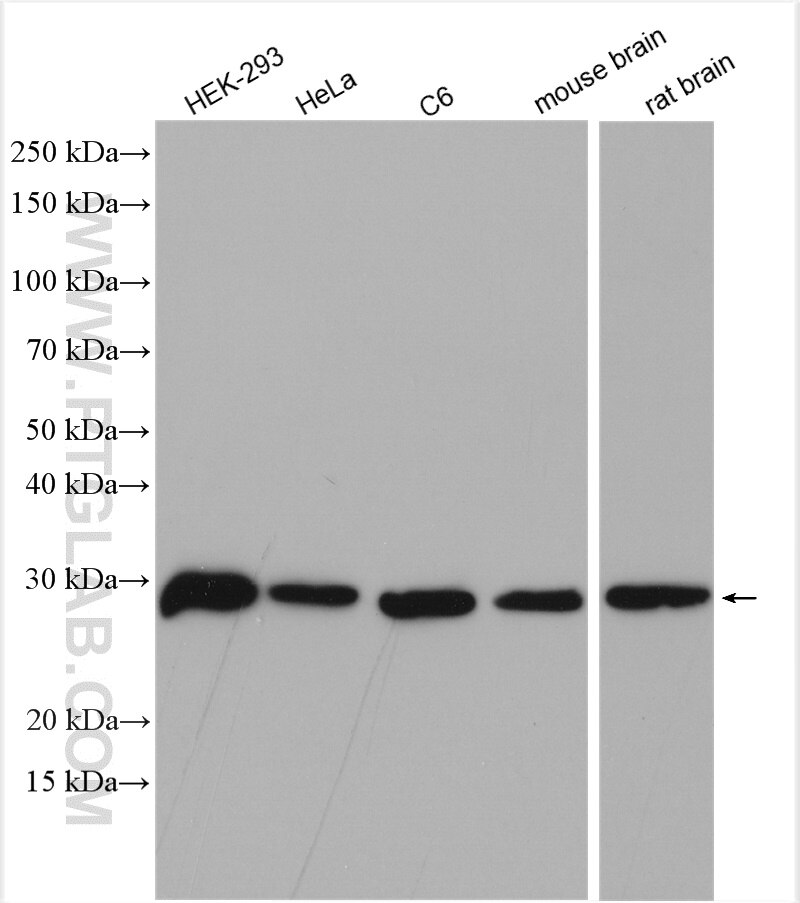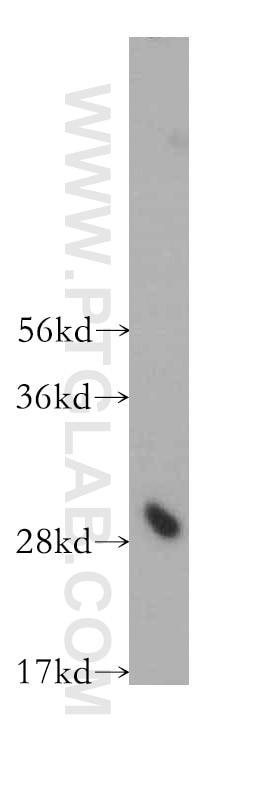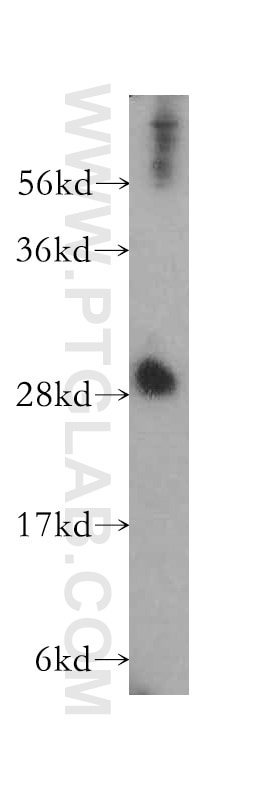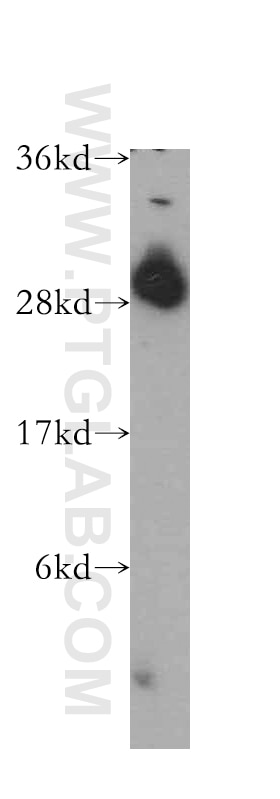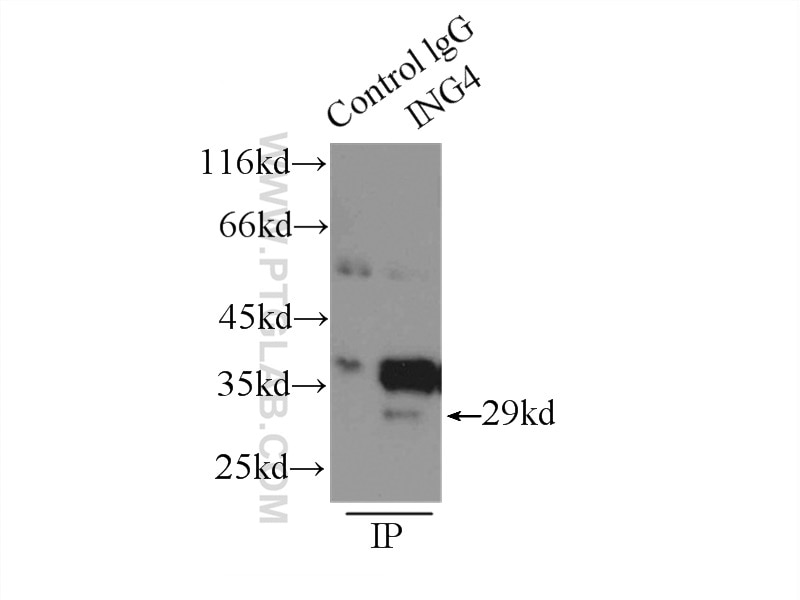- Phare
- Validé par KD/KO
Anticorps Polyclonal de lapin anti-ING4
ING4 Polyclonal Antibody for WB, IP, ELISA
Hôte / Isotype
Lapin / IgG
Réactivité testée
Humain, rat, souris
Applications
WB, IP, IF, IHC, ELISA
Conjugaison
Non conjugué
N° de cat : 10617-1-AP
Synonymes
Galerie de données de validation
Applications testées
| Résultats positifs en WB | cellules HEK-293, cellules C6, cellules HeLa, tissu cérébral de rat, tissu cérébral de souris |
| Résultats positifs en IP | cellules HEK-293 |
Dilution recommandée
| Application | Dilution |
|---|---|
| Western Blot (WB) | WB : 1:2000-1:16000 |
| Immunoprécipitation (IP) | IP : 0.5-4.0 ug for 1.0-3.0 mg of total protein lysate |
| It is recommended that this reagent should be titrated in each testing system to obtain optimal results. | |
| Sample-dependent, check data in validation data gallery | |
Applications publiées
| KD/KO | See 1 publications below |
| WB | See 7 publications below |
| IHC | See 9 publications below |
| IF | See 2 publications below |
| IP | See 2 publications below |
Informations sur le produit
10617-1-AP cible ING4 dans les applications de WB, IP, IF, IHC, ELISA et montre une réactivité avec des échantillons Humain, rat, souris
| Réactivité | Humain, rat, souris |
| Réactivité citée | Humain, souris |
| Hôte / Isotype | Lapin / IgG |
| Clonalité | Polyclonal |
| Type | Anticorps |
| Immunogène | ING4 Protéine recombinante Ag0960 |
| Nom complet | inhibitor of growth family, member 4 |
| Masse moléculaire calculée | 29 kDa |
| Poids moléculaire observé | 29 kDa |
| Numéro d’acquisition GenBank | BC007781 |
| Symbole du gène | ING4 |
| Identification du gène (NCBI) | 51147 |
| Conjugaison | Non conjugué |
| Forme | Liquide |
| Méthode de purification | Purification par affinité contre l'antigène |
| Tampon de stockage | PBS avec azoture de sodium à 0,02 % et glycérol à 50 % pH 7,3 |
| Conditions de stockage | Stocker à -20°C. Stable pendant un an après l'expédition. L'aliquotage n'est pas nécessaire pour le stockage à -20oC Les 20ul contiennent 0,1% de BSA. |
Informations générales
ING4, also named as p29ING4, belongs to the ING family. It is a component of the HBO1 complex which has a histone H4-specific acetyltransferase activity, a reduced activity toward histone H3 and is responsible for the bulk of histone H4 acetylation in vivo. It may inhibit tumor progression by modulating the transcriptional output of signaling pathways which regulate cell proliferation. ING4 can suppress brain tumor angiogenesis through transcriptional repression of RELA/NFKB3 target genes when complexed with RELA. It may also specifically suppress loss of contact inhibition elicited by activated oncogenes such as MYC. Represses hypoxia inducible factor's (HIF) activity by interacting with HIF prolyl hydroxylase 2 (EGLN1). ING4 is a tumor suppressor gene that interacts with NFkB and represses its transcriptional activity. Several lines of evidence suggest that the tumor suppressor gene ING4, NFkB and its target genes matrix metalloproteases MMP-2, MMP-9 and u-PA are critically involved in tumor invasion. This antibody is a rabbit polyclonal antibody raised against full length human ING4 antigen.
Protocole
| Product Specific Protocols | |
|---|---|
| WB protocol for ING4 antibody 10617-1-AP | Download protocol |
| IP protocol for ING4 antibody 10617-1-AP | Download protocol |
| Standard Protocols | |
|---|---|
| Click here to view our Standard Protocols |
Publications
| Species | Application | Title |
|---|---|---|
Adv Sci (Weinh) Inhibition of CK2/ING4 Pathway Facilitates Non-Small Cell Lung Cancer Immunotherapy | ||
Blood The Hbo1-Brd1/Brpf2 complex is responsible for global acetylation of H3K14 and required for fetal liver erythropoiesis. | ||
Cancer Res Transient Induction of ING4 by MYC Drives Prostate Epithelial Cell Differentiation and its Disruption Drives Prostate Tumorigenesis. | ||
Oncogene Aberrant CREB1 activation in prostate cancer disrupts normal prostate luminal cell differentiation. | ||
Carcinogenesis Role of ING4 in human melanoma cell migration, invasion and patient survival. | ||
Mol Cell Biol The ING4 tumor suppressor attenuates NF-kappaB activity at the promoters of target genes. |
